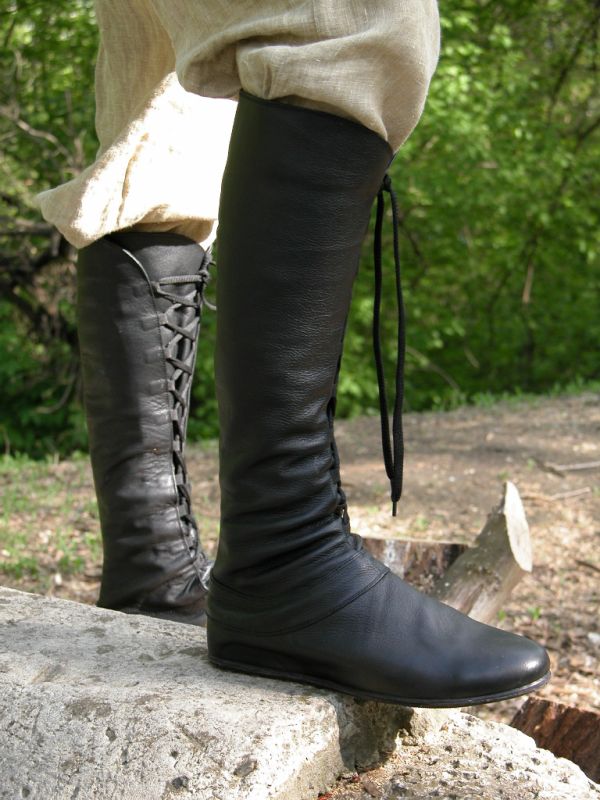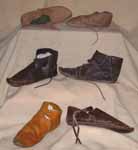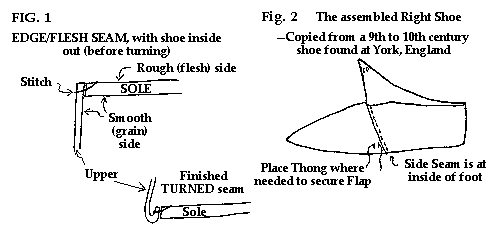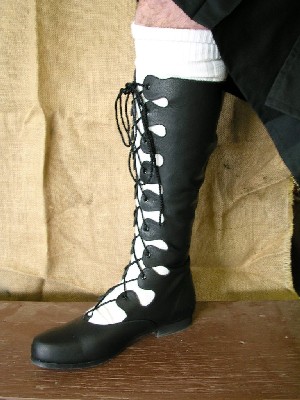Footwear
Contents
The shoe in history
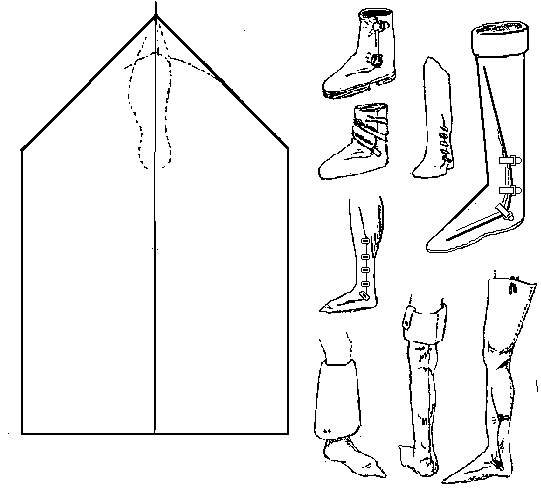
N. A shoe is an item of footwear. Shoes may vary from a simple flip-flop to a complex boot. Shoes may have high or low heels, although in western cultures, high heels are considered a women's style. Shoe materials include leather or canvas. Athletic shoe soles may sometimes be made of rubber.
The earliest known shoes date from about 8000 to 7000 BCE and were found in Oregon, USA in 1938. However, the materials used for making shoes (typically tanned leather) do not normally last for thousands of years, so shoes were probably in use long before this. Physical anthropologist Erik Trinkaus believes he has found evidence that the use of shoes began in the period between about 40,000 and 26,000 years ago, based on the fact that the thickness of the bones of the toes (other than the big toe) decreased during this period, on the premise that going barefoot results in greater bone growth before this period.
The earliest designs were simple affairs, often mere "foot bags" of leather to protect the feet from rocks, debris, and cold. Since a shoe uses more leather than a sandal, their use was more common amongst people in cold climates. By the Middle Ages, turn-shoes had been developed with toggled flaps or drawstrings to tighten the leather around the foot for a better fit. As Europe gained in wealth and power, fancy shoes became status symbols. Toes became long and pointed, often to ridiculous proportions. Artisans created unique footwear for rich patrons, and new styles developed. Eventually the modern shoe, with a sewn-on sole, was devised. Since the 17th century, most leather shoes have used a sewn-on sole. This remains the standard for finer-quality dress shoes today.
Historical Shoes
Footwear has been worn for tens of thousands of years. Shoes of the past include:
Turn-shoes: A method by which the shoe is constructed inside-out, wetted, and turned — the finished side of the leather flipped to the outside. Such footwear was common from the Middle-ages until modern shoes was developed in the Tudor era. Because of their construction, turn-shoes cannot simply be re-soled, unlike most modern shoe types.
Espadrilles: these sandals, which are still worn today, are found as early as the 14th century.
Patten: a European wooden overshoe used to keep a person's feet dry outdoors. First worn in the middle ages, they continued in use even into the early 20th century. Peoples such as the Dutch, Flemings, and some French carved similar, fully enclosed wooden shoes.
Poulaine: a shoe with a long-pointed toe, popular in Europe in the 1400s.
Moccasins: the historical shoe of many North American Indian tribes.
Glossary of terms
Last: Foot shaped wooden form on which shoes are stretched and sewn.
Turn- Shoe: Shoe manufactured by stitching leather inside out in the early stages of construction.
Pattens: Wooden hinged sandals worn over shoes. Their purpose is to protect your shoes (and not incidentally your feet) from mud and abrasive surfaces.
Tunnel stitch: A stitch that does not completely penetrate the leather. Generally used for sewing on reinforcing cords and heel stiffener.
Reinforcing cord: A piece of linen cord that is tunnel stitched to leather to add strength. Often used across seams to strengthen them and prevent gapping. Also used around large, high stress openings to prevent the leather from stretching.
Heel stiffener: A piece of leather tunnel stitched over the heel to prevent undue stretching of the leather at this spot.
Sole The bottom of a shoe is called the sole.
Insole The insole is the interior bottom of a shoe, which sits directly beneath the foot. Many shoes have removable and replaceable insoles, and extra insoles are often added for comfort or health reasons (to control the shape, moisture, or smell of the shoe).
Outsole The outsole is the layer in direct contact with the ground. Dress shoes have leather outsoles; casual or work-oriented shoes have outsoles made of natural rubber or a synthetic imitation. The outsole may comprise a single piece, or may comprise separate pieces of different materials. Often the heel of the sole is rubber for durability and traction, while the front is leather for style. Specialized shoes will often have modifications on this design: athletic cleats have spikes embedded in the outsole to grip the ground; many kinds of dancing shoes have much softer or harder soles.
Midsole The layer in between the outsole and the insole that is typically there for shock absorption. Some types of shoes, like running shoes, have another material for shock absorption, usually beneath the heel where one puts the most pressure down. Different companies use different materials for the midsoles of their shoes. Some shoes may not have a midsole at all.
Heel The bottom rear part of a shoe is the heel. Its function is to support the heel of the foot. They are often made of the same material as the sole of the shoe. This part can be high for fashion or to make the person look taller, or flat for a more practical use.
Vamp, or upper Any shoe has an upper part that helps hold the shoe onto the foot. In the simplest cases, such as sandals or flip flops, this may be nothing more than a few straps for holding the sole in place. Closed footwear, such as boots, sneakers and most men's shoes, will have a more complex upper. This part is often decorated or is made in a certain style to look attractive. The U.S. Patent 3,355,535 , from 1967, describes a method for producing a shoe-upper (Hain 1967).
Turn Shoes how to
Left, shoes made by Matthew Amt. At top are two made from the pattern below, using garment leather and sewn by machine. Middle left is a 10th century style copying an example from Durham, and next to it is a very similar 12th century type. Both have chrome-tanned leather uppers, but are hand-stitched with proper turn-shoe construction. Bottom left is a 13th century shoe fastened by two overlapping tabs with little "toggles" (short knotted thongs in this case). Bottom right is an approximation of a 14th or 15th century shoe fastened with a forked strap that passes through a pair of holes and ties. The leather and construction are not quite right, but the overall effect is decent, and it has very correct repair soles sewn on with tunnel stitches. (All of these are for the right foot.)
Most medieval shoes were "turn shoes", sewn together inside out and then turned rightside out, to keep the stitching protected from wear. The sole is sewn to the upper with an edge/flesh seam: the stitch passes straight through the upper, then into the edge of the sole and out through the flesh (rough) side (fig 1). The edges of the uppers can be butted together and sewn with an edge/flesh seam, or simply overlapped and stitched straight through.
Like almost all shoes of the period, this pattern has an upper of one main piece with the seam on the inside of the foot; small inserts are added to close any gaps. The toe is pointed, and there can be an embroidered stripe running from the toe to the throat. Shoes were made with a right and left, and could be slip-ons or fastened with a drawstring.
Most surviving medieval shoes are made from very thin leather. Most reproductions are "over-engineered" and made from thicker leather (including my own), up to about 4 to 6-ounce for the uppers and 7 to 8-ounce for the soles. Be sure to use topgrain vegetable-tanned leather, not suede or chrome-tanned. (Click here for a page of leather tips: www.larp.com/legioxx/leather.html) Before doing any cutting, make a good working pattern out of scrap cloth and cardboard that fits your foot. The "seam allowance" around the bottom edge of the upper will be 1/4" to 3/8", but the sole should have NO seam allowance, since the upper is sewn against its edge. It will look very narrow.
When sewing the upper and sole together, start at the toe and sew the outside, then start again at the toe and sew the inside. Keep your stitches small and tight. A helpful trick is to glue the pieces together with leather glue or contact cement first, then stitch them. (Glue alone will NOT hold the pieces together without stitching!) Also, you may wish to turn the shoe before sewing the side seam or adding any inserts. The shoe must be soaked in water for several hours before it can be turned. When the shoe has been turned and has dried completely, coat it well with neatsfoot oil to make it waterproof and supple.
The thin soles of medieval shoes are not as protective as modern soles, of course, so you may want to insert padded or heavier leather insoles for more comfort. On the other hand, smooth leather soles can be slippery on wet grass, but a thin sole allows the toes to dig in more for better traction.
Shoes in Amtgard
Period footwear is probably the rarest kind of garb in all of Amtgard. As with many things there are 3 things to consider 1.) Good 2.) Fast 3.) cheap. Of those 3, odds are you're gonna have to settle for 2 of them.
You can make them yourself, sucker somone into making them for you, or buy some. Making shoes is not the eaisest thing in the world. Making shoes normally takes leatherworking skills and sewing skills, below I will attempt to layout what goes into making shoes, then links.
Leather is the material of choice for footwear. Latigo is the best kind, but it is expensive. Vegetable tanned leather is the second choice, it is the closest thing to period leather in stores. Chrome tanned leather should be avoided because after prolonged exposure to moisture the chrome salts will leach out and your leather will turn back to rawhide. Also it is worth to note many medieval Japanese shoes were made from woven grass.
The sole of a shoe is normally made from layers of leather at least 8oz thick stiched or glued together. not just any glue will due to keep the layers together, it's gotta be hella tough. Throughout history woden soled shoes have been worn and refered to as clogs (not those dutch shoes, though they are clogs most other clogs just had wooden soles) and were often worn by the poor. It was not uncommon for many shoes to be hobnailed to slow wear on the sole from ancient times through world war 2.
The uppers are normally leather as well, open toed uppers such as calige or ghillies(not open toed but does not need a last)often will negate the need for a last. The upper is usually sandwiched in the layers of the sole to keep it in place.
Links
- "Footwear of the middle ages"
- Atlantian A&S on the topic
- Calcei
- A LOTR costume page's shoe department
- 1st century caligae (steryotypical roman boot)
- Historical footwear by Marc Carlson
- Gallery of Turn Shoes
- purchase turn shoes
- Cheap hobnails, but not 100%accurate though better than nothing.- you want the 5/8" length
- Roy Najecki
- *VERY* authentic hobnails for ancient times -scroll the bottom to see the hobnails.
- Renboots
- Bohemond's boots
- Par Fabrica
